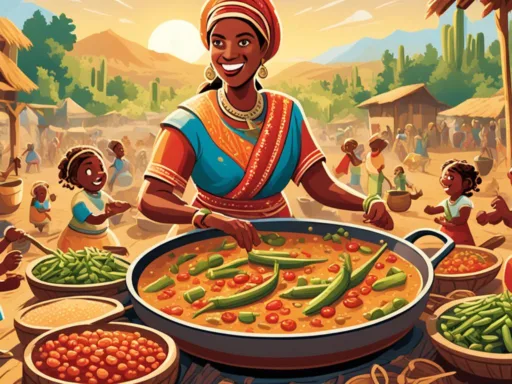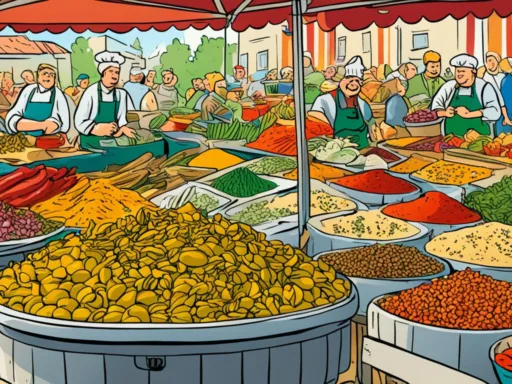Far beyond the familiar culinary landscapes, Togolese cuisine stands as an uncharted symphony of tastes waiting to be discovered. Could a small West African nation like Togo be home to some of the most diverse and richly flavored dishes in the global culinary scene? Embark on an epicurean quest with us as we explore the vibrant shades of Togolese food discoveries, from maize-based delights to spicy, flame-grilled bites that are bound to leave your palate yearning for more. Unwrap the stories behind Traditional Togolese dishes that weave the essence of a rich cultural tapestry onto your plate.
Key Takeaways
- Discover the unique and bold flavors that define Traditional Togolese dishes.
- Learn about the key ingredients that form the backbone of Togolese food discoveries.
- Get acclimated with the multifaceted cultural influences ingrained within Togolese cuisine.
- Unearth the culinary secrets that make Togo’s gastronomy a hidden gem in the world of food.
- Appreciate the simplicity and complexity interwoven in the fabric of Togo’s rich food traditions.
Unveiling the Origins of Togo’s Name and Landscape
As we embark on a Togo food exploration, it becomes essential to understand the rich context from which traditional Togolese dishes have emerged. The very essence of Togo’s name is steeped in the history and geography of this vibrant land, shaping its cultural and culinary identity.
The Ewe People and the Meaning Behind Togo
At the core of Togo’s identity are the Ewe people, whose language bequeathed the name of the country. “Togo” draws from the Ewe phrases “toh” signifying “river” and “godo” meaning “on the other side,” beautifully narrating the landscapes that the Ewe people call home. The tapestry of Togo’s heritage is as rich and diverse as the dishes that are central to its food culture.
Geography: From the Shores of Lake Togo to the Coastal City of Lomé
From the tranquil waters of Lake Togo stretching to the palm-fringed Gulf of Guinea, Togo’s geography shapes not only its scenery but also its palate. Lomé, the capital city, dubbed the “Paris of West Africa,” provides a cosmopolitan counterpoint to the natural backdrop, as both influence the country’s food scene.
Exploring Togo’s National Parks and Wildlife Diversities
Togo’s national parks, such as the Fazao-Malfakassa National Park, are a testament to the country’s commitment to preserving its natural wonders. These parks are home to diverse ecosystems that not only contribute to Togo’s environmental conservation efforts but also offer ingredients that inspire traditional Togolese dishes—a true Togo food exploration.
An Exploration of Togo’s Historical Tapestry
The rich history of Togo is woven from a fabric of early settlements, a mix of external influences, and a vibrant political evolution. Each thread of Togo’s past contributes to its cultural identity and even informs contemporary Togolese recipes and Togolese cooking methods. Let’s delve into the significant eras that have shaped Togolese society and its culinary traditions.
The Early Settlements and Artisanal Traditions
Between the 11th and 16th centuries, several tribes known for their abilities in pottery and metalwork made their homes along the Togolese coastline. These artisanal skills have been passed down through generations and can be seen reflected in the tools and methods used in traditional Togolese cooking methods still practiced today.
Togoland: The Era of Colonial Influence
Following a period as a hub in the Atlantic slave trade, Togo fell under colonial rule, which began with Danish occupancy and transitioned to German overlordship. This colonial period brought significant changes and introduced new components to the nation’s cooking, influencing the development of diverse Togolese recipes found throughout the country.
The Rise of Independence and Political Evolution
After the division of Togoland post World War I and subsequent independence from France in 1960, Togo has endured political turmoil. Even amidst upheaval, the steadfast resilience of the Togolese people is mirrored in the perseverance of their cultural customs, particularly within their culinary arts which hold steadfast to timeless Togolese recipes and methods.

Decoding the Multifaceted Togolese Culture
The Togolese culture is as rich and diverse as the flavors found in its cuisine. It is an intricate mosaic that portrays the compelling story of a nation with deep-rooted traditions and a vibrant mix of ethnicities. This cultural wealth influences every aspect of life in Togo, including its distinguished Togolese food culture and the preparation of authentic Togolese meals, which are considered a fundamental part of the nation’s identity.
The Mosaic of Ethnicities and Languages
Togo’s social fabric is made up of a striking variety of ethnic groups, each contributing its unique thread to the national tapestry. The Ewe group, known for its flourishing arts and complex belief systems, stands out among the others for its significant cultural impact. Despite the multiplicity of native languages spoken across regions, French weaves these groups together as the lingual thread binding Togo’s cultural quilt.
Religious Beliefs and Practices: Voodoo and Animism
One of the most distinctive features of Togolese culture is its spiritual landscape, where Voodoo and Animism are more than just religions—they are the lifeblood of the community. These belief systems shape the way Togolese people interact with the world, imparting a reverence for nature and the unseen forces that govern life. These ancient practices are patriotically guarded, showcasing the profound depth of Togolese spirituality.
Expressions through Music, Dance, and Oral Literature
Equally expressive are the arts of music and dance, acting as the rhythmic heartbeat of Togo’s cultural life. Traditional festivals and ceremonies are clad in the vibrant attires of resonant drums and fluid dance, storytelling through motion. Meanwhile, the rich oral literature of Togo, with its treasure trove of proverbs and folktales, continues to be an important vessel for cultural transmission and education throughout the generations.
In essence, understanding Togolese culture is an essential ingredient in appreciating the layers and nuances found within its sophisticated cuisine. The reverence for tradition and community inherent in the preparation of authentic Togolese meals is a direct reflection of the multifaceted cultural landscape of this captivating country.
Togolese Culinary Delights: A Rich Blend of Flavors
The harmonious marriage of staple ingredients and complex taste profiles positions Togolese culinary delights as a symbol of the nation’s vibrant gastronomy. Deeply rooted in the fertile West African soil and its agrarian traditions, Togo’s food landscape offers an authentic foray into Togo food exploration.
Amidst this culinary backdrop, maize emerges as a beloved cornerstone, transforming into various traditional dishes that resonate with the warmth of Togolese hospitality. With the nation’s coastline yielding a bounty of seafood, an assortment of proteins embellishes the tables inland, making Togolese cuisine a comprehensive narrative of its people and their connection to the land.
| Ingredient | Culinary Uses | Regional Significance |
|---|---|---|
| Maize | Porridges, side dishes | Maize is a backbone of Togolese staples, versatile and omnipresent. |
| Tropical Fruits | Desserts, snacks, juices | Sweet mangoes, pineapples, and papayas are the jewels of Togo’s natural larder. |
| Fish | Grilled, stewed, smoked | The coastal traditions exemplify the importance of fresh seafood in Togolese diet. |
| Regional Vegetables | Stews, sauces, accompaniments | Vegetables like okra and spinach feature prominently in sauces and stews. |

The echoes of Togo’s colonial legacy are subtly interwoven in its cuisine, where European influences punctuate the diverse flavor palette with the common sight of beer and baguettes. Nevertheless, the true essence of Togolese culinary delights lies in the rich tapestry of locally sourced ingredients and time-honored cooking methods.
“Togolese cuisine is a celebration of taste and tradition, an edible mosaic of our rich cultural tapestry.”
- Colonial Influence: The inclusion of beer and baguettes alongside indigenous flavors.
- Agricultural Roots: Predominance of maize, reflecting Togo’s staple food culture.
- Coastal Offerings: Abundant seafood marking coastal dietary habits.
- Taste Complexity: Rich sauces and stews highlighting the depth of local cuisine.
The complexity and simplicity of Togo’s culinary profile reflect not only a diverse palate but also the essence of a culture that finds unity and identity in its food. The journey through Togolese kitchens is both a tactile and a flavorful adventure, offering insight into the country’s soul, one dish at a time.
The Heart of Togolese Cuisine: Staple Foods and Ingredients
Delving into the culinary essence of Togo unveils a gastronomy largely defined by the hearty staples that have sustained its people for generations. From the maize fields echoing with the sounds of harvest to the bustling market stalls laden with ripe plantains and cassava, each element contributes to the rich tapestry of Traditional Togolese dishes. As we explore the deep-rooted Togolese recipes, it becomes clear that these key ingredients are not mere sustenance but a reflection of the nation’s identity and resourcefulness.

Maize, Fufu, and the Staples of Subsistence
Maize is not just a crop; it is the centerpiece of Togolese cuisine. A versatile grain, its culinary forms are as diverse as the Togolese landscapes. Perhaps the most iconic manifestation is fufu, a beloved staple where maize flour is alchemically transformed with cassava, plantains, and yams into a dough-like consistency – a culinary staple that is both simple and profoundly satisfying.
Plantains, Cassava, and the Vegetal Bounty
Symptomatic of the rich agricultural tapestry in Togo, plantains and cassava appear across a multitude of dishes, offering not only nutrition but also a canvas for the vivid flavors that define Togolese cooking. These staples, often cooked, roasted, or mashed, underpin the nation’s dietary framework and provide a fulfilling base to the vibrant stews that grace every Togolese table.
Protein in Togolese Diet: The Use of Fish, Meat, and Legumes
Protein sources are not overlooked in Togolese cuisine, as they offer a critical balance to the carb-heavy staples. Coastal communities turn to the bountiful Atlantic for fish and shellfish, seamlessly incorporated into recipes with a splash of culinary ingenuity. Inland, a reliance on poultry, goat, and legumes adds depth and substance to the meals, often punctuated by the nutty essence of groundnuts, which are not just a crop but a cornerstone of both economy and nutrition.
Through this exploration of the fundamental foods and ingredients of Togo, we gain insight into the robust backbone of its culinary heritage. Each dish tells a tale of adaptation and artistry – a testament to the enduring spirit and cultural vibrancy encapsulated within every Togolese meal.
A Taste of Traditionality: Popular Togolese Dishes
The culinary tapestry of Togo is embellished with rich flavors that are deeply embedded in the nation’s cultural fabric. The traditional Togolese cooking methods evoke a sense of authenticity that is hard to replicate, with dishes that carry the essence of the land and its heritage. Let’s delve into the popular dishes that offer a glimpse into this vibrant culinary world.
Exploring the Spicy Marinades and the Art of Grilling
One of the hallmarks of Togolese cuisine is its mastery of the grill. Whether it’s the searing of meats or the gentle charring of vegetables, the smoky aroma is a telltale sign of an authentic Togolese meal. The spicy marinades, often a blend of local spices and aromatics, are a testament to the skillful seasoning that Togo’s traditional dishes are known for.
Djenkoume: A Cornmeal Delicacy with Tomato Essence
Djenkoume, a fond favorite in Togolese households, is a cornmeal-based delight that truly showcases the simple yet robust flavors of the region. This delicacy, often shaped into balls and infused with a rich tomato sauce, is a comforting embodiment of Togolese simplicity and flavor.
Sweets and Beverages: From Akpan to Palm Wine
The sweetness in Togo’s cuisine doesn’t necessarily come from elaborate confections but rather from the natural bounty of its land. Ripe mangoes, pineapples, and bananas lead the way, while akpan, a fermented maize yogurt, introduces an intriguing twist to the spectrum of Togolese tastes. Palm wine, or sodabe, provides a heady complement to these sweet treats with its refreshing and subtle alcoholic bite.
| Dish | Main Ingredients | Flavor Profile | Cooking Method |
|---|---|---|---|
| Koklo Meme | Chicken, marinades | Spicy, smoky | Grilled |
| Djenkoume | Cornmeal, tomato sauce | Savory, hearty | Boiled and formed |
| Akpan | Fermented maize | Tangy, refreshing | Fermented |
| Sodabe | Palm sap | Sweet, alcoholic | Distilled |
These dishes and beverages highlight the remarkable culinary diversity of Togo. From the heat of the grill to the sweetness of ripe fruits, the array of authentic Togolese meals is bound to captivate and enchant food lovers and culture enthusiasts alike.
Togolese Food Discoveries: Authentic Meals and Street Foods
Embark on a savory journey through the streets of Togo, where the essence of Togolese culinary delights is showcased in bustling markets and roadside stands. Bursting with aromas and flavors, Togo’s street food scene offers an unfiltered peek into the country’s rich gastronomic traditions, with vendors serving up hearty and authentic fare to hungry locals and curious travelers alike.
Discovering Togo’s Street Food Scene
From the sizzle of kebabs over hot coals to the sweetness of ripe fruit, Togo’s street food landscape is as diverse as it is flavorful. Vendors dish out delectable eats such as kelewele (spicy fried plantains), steaming bowls of gboma dessi (spinach stew), and generous servings of jollof rice, creating an unforgettable Togo food exploration for all your senses.
Unique Dining Practices and Etiquette in Togo
The heart of Togolese culture is beautifully reflected in its dining etiquette. Here, meals are a communal affair, often eaten without utensils, allowing for a direct and intimate experience with the meal before you. Even in the simplicity of this traditional practice, there’s an unspoken protocol to dining in Togo: always use your right hand and join in the shared reverence for the delicious homemade flavors of Togolese cuisine.
Here’s a table highlighting some of the most popular street foods you’ll discover on your Togo food exploration:
| Street Food | Description | Typical Ingredients |
|---|---|---|
| Kelewele | Spicy and sweet fried plantains. | Plantains, ginger, cayenne pepper, oil. |
| Gboma Dessi | Rich and savory spinach stew. | Spinach, tomato, onion, fish, spices. |
| Jollof Rice | Iconic West African spiced rice dish. | Rice, tomatoes, onions, peppers, spices. |
| Akpan | Yogurt-like snack made from fermented corn dough. | Corn dough, sugar, water, sour milk. |
| Sodabe | Local palm wine, a refreshing alcoholic beverage. | Sap of palm tree, fermentation. |
Whether you’re nibbling on street snacks or diving into a full dish, every Togolese culinary delight you encounter is a chapter in the delicious story of this vibrant country. So, come ready to eat, explore, and embrace the welcoming spirit of Togo’s food culture.
Setting the Table: Togolese-inspired Ambiance and Presentation
To immerse oneself in the Togolese food culture is to engage with a tableau of vibrancy and symbolism that transcends mere eating. As Traditional Togolese dishes are central to the nation’s identity, so too is the presentation and environment in which they are enjoyed. A quintessential Togolese table is a canvas painted with the patriotic hues of the national flag, and each meal is elevated to a ceremonious occasion with the infusion of customary music meant to satiate the soul as well as the palate.
Symbols and Colors: The Immersive Eating Experience
The dining setting in Togo is a deliberate arrangement designed to kindle a sense of national solidarity. Each color adorning the table holds profound significance; green symbolizes the fertile Togolese landscapes, yellow reflects the country’s mineral wealth, red conjures the ancestors’ valor, while white offers peace and hope for the future. Programmatically placed symbols such as stars elucidate aspirations and dreams, and red roses evoke the beauty of Togo’s national flower, symbolizing the enduring love for the land.
Musical Backdrop: The Role of Kobi Lolo in Dining
Amidst the flavorsome offerings of an authentic Togolese meal, one can expect to be wrapped in the rhythmic embrace of Kobi Lolo, a genre echoing the heartbeats of Togo. This music, essential to Togolese food culture, provides more than a mere backdrop; it acts as a spiritual companion that resonates with each savored bite. Traditionally, it enhances the overall dining experience, fusing the gustatory joy of eating with an auditory celebration of local traditions and conviviality.
| Color | Symbolism | Representation at the Table |
|---|---|---|
| Green | Fertility of the Land | Greenery and Plant-based Ingredients |
| Yellow | Country’s Wealth | Bright Table Accents |
| Red | Valor and Sacrifice | Red Roses and Spicy Elements |
| White | Peace and Hope | Clean Linens and Crisp Atmosphere |
Embracing the Togolese Way Through Proverbs and Cuisine
The essence of Togolese food culture is often captured in the rich tapestry of its proverbs, speaking to the heart of the nation’s timeless wisdom. Through these sayings, one can glean a deeper appreciation for the values and philosophical insights that Togolese culinary delights bring to the table.
Connecting Through Common Sayings
Proverbs are the seasoning of conversation, and in Togo, they are liberally sprinkled throughout discussions that often revolve around food, family, and community. Here, food is more than sustenance; it’s a communal thread that binds the very fabric of social life.
The Philosophical and Cultural Insights Behind Togo’s Food
Each dish tells a story, revealing the nation’s history, its struggles, and triumphs. Ingredients are not just nutritional components; they carry cultural significance and ancestral knowledge, embodied in the hands that prepare them and the mouths that savor them.
| Togolese Proverb | Meaning in Cuisine | Culinary Example |
|---|---|---|
| “Aza kpodo déka sisi, ayi nungunungu déka ta.” | Direct translation: “A crab does not give birth to a bird.” This implies staying true to one’s roots and origins. | Fufu and okra soup, a traditional dish that remains largely unchanged through generations, symbolizing the preservation of culinary heritage. |
| “Edze adeka la, vovor le zo.” | Direct translation: “If the mountain won’t come to you, go to the mountain.” Adaptability and making the most of available resources. | Grilled maize, a simple yet adaptable snack that reflects making the best of the harvest and local resources. |
| “Susu kpakpa bo adze a, na e fe eme.” | Direct translation: “A good fish sells itself.” Signifies the value of natural quality and reputation. | Seafood by the coast, especially grilled fish, which is renowned for its freshness and requires little additional flavor to be enjoyed. |
Through the lens of Togolese culinary delights, we can see not just a cuisine, but a narrative that conveys the collective philosophy of its people. Food preparation in Togo is never just about the act itself, but the beliefs, aspirations, and community spirit of the Togolese people, making it an art form rich in cultural wisdom.
The Intersection of Togolese Cuisine and Social Practices
The dynamic relationship between Togolese social customs and cuisine paints a picture of a culture where food is at the very heart of celebration and heritage. Togo food exploration takes on a deeper meaning when seen against the backdrop of the country’s vibrant festivals and historical landmarks.
Festivals and Food: The Evala Wrestling Celebrations
When it comes to the annual Evala wrestling celebrations, authentic Togolese meals become an integral part of the event’s fabric. This week-long festival is not merely about the physical prowess displayed in the wrestling matches but is equally about the feasting on traditional dishes that accompany the revelry. Specialties such as ‘Pâte’ with ‘Gboma’ sauce and smoked fish are not just sustenance but markers of identity and honor for the Kabyè people participating in and observing the festivities.
UNESCO Heritage and Togolese Cuisine: Koutammakou
The Koutammakou landscape, a UNESCO World Heritage site in northern Togo, offers an extraordinary blend of history and culinary tradition. In these famed terrains, where the iconic Takienta tower-houses rise from the earth, food serves as a symbol of the Batammariba people’s close ties to their land. A visual and gastronomic journey through Koutammakou uncovers the vital role of agriculture and its bounty in shaping the distinct flavors of Togo’s cuisine.
| Event/Festival | Signature Dish | Ingredients | Cultural Significance |
|---|---|---|---|
| Evala Wrestling | Pâte with Gboma Sauce | Corn dough, spinach, tomatoes, spices | Represents strength and unity among the Kabyè tribe |
| Koutammakou Visit | Grilled Guinea Fowl | Guinea fowl, local spices, marinade | Highlights the importance of game meat in Batammariba diet |
Within these harmonious celebrations, each dish seasoned with local spices and native cooking methods stands as testament to Togo’s rich cultural mosaic. To engage in Togo food exploration is to dive headlong into the spirited heart of West Africa, where every bite tells a story of festivity, struggle, and unity—a true adventure for the culinary explorer.
Conclusion
As we wrap up our exploration, the vibrant tapestry of Togolese cuisine stands as a compelling narrative, intertwined with the nation’s cultural and historical journey. Through the journey of Togolese Food Discoveries, we’ve seen how Traditional Togolese dishes not only provide sustenance but also convey stories, celebrate heritage, and express the communal ethos that Togo prides itself on. Each dish, from the simplest to the most elaborate, serves as a chapter in the larger story of Togo’s rich traditions and resilient spirit.
A Culinary Reflection: Togo’s Food as a Mirror of Its Identity
Togo’s diverse gastronomy deeply reflects its identity, telling tales of colonial influence, indigenous legacies, and the unyielding ties to nature’s bounty. The flavors we’ve encountered—smoky, spicy, earthy—are as complex and nuanced as the history that has shaped this nation. The significance of these dishes goes far beyond taste alone; they are emblematic of Togo’s societal fabric—a cultural latticework that is vividly captured through its food.
Leaving a Taste of Togo: Final Thoughts on Our Gastronomical Trip
Our culinary voyage may have reached its end, yet the memories of Togo’s palatable charms linger, inviting us to revisit and rediscover. The tireless pursuit of Togolese Food Discoveries has engraved in us a deep appreciation for the nation’s flavors as well as the stories behind them. We leave Togo with a richer understanding and a heart full of the warmth that only Traditional Togolese dishes can proffer—an experience that resonates not just on our palates but within our collective global narrative.






